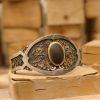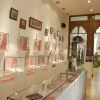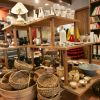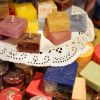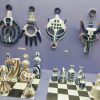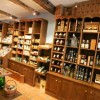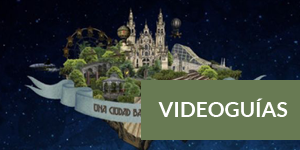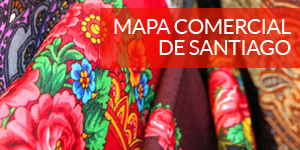- Accede I
- Regístrate I
- carrito
Qué comprar en Santiago
El número de objetos artesanales típicos es muy variado: desde botafumeiros a joyas de plata y azabache -la piedra mágica de la ciudad-, reproducciones de la Cruz de Santiago, conchas de vieira jacobea, cirios, imaginería y objetos para el culto, cerámica popular, loza decorativa de la marca Sargadelos, amuletos celtas, higas contra los maleficios o gaitas, el instrumento musical gallego por excelencia.
Y moda, porque Galicia es uno de los centros creadores de la costura española, que exporta a todo el mundo. Marcas como Adolfo Domínguez, Zara, Roberto Verino, Florentino, Purificación García o Antonio Pernas tienen tiendas por todo Santiago. Pero la tradición textil no viene de ahora: los finos encajes de bolillos y los tejidos de lino se siguen elaborando igual que en el pasado.
Y para pequeñas compras, en pleno casco histórico, en la Rúa Nova, hay un mercadillo al aire libre que abre todos los días del año de 10 a 20:30 h. Es el mercadillo 'hippie', y en él encontrará regalos diversos: desde bisutería y complementos a objetos artesanos de cuero. Los jueves y sábados, además, puedes visitar el mercadillo de antigüedades que se celebra en la Praza de Cervantes (jueves) y Rúa do Franco (sábado) en horario de 9 a 14:00 h.
Artesanía
El paseo por las calles de Santiago supone el descubrimiento de pequeñas tiendas y talleres que encarnan la trayectoria milenaria de la ciudad como receptora de las tradiciones artesanales de toda Europa. La paciente producción, reunida bajo la marca registrada de ‘Artesanía de Compostela’, incluye desde sombreros a vajillas; desde velas, exvotos e imágenes sagradas hasta objetos de forja ornamental, grabados, vidrio, orfebrería, esmalte, cerámica o cuero salidos de más de 300 talleres.
La intensa actividad artesanal ha dejado su marca en un mapa urbano en el que resuenan los nombres de los oficios, algunos ya desaparecidos. Es el caso de los barrios de Concheiros y Pelamios –donde se concentraban los vendedores de conchas y los curtidores de pieles, respectivamente- o el de las plazas de As Praterías y Acibechería. Además, un oficio da origen al gentilicio popular de picheleiros con el que se conoce a los compostelanos. La voz procede de ‘pichel’ –jarra de estaño- y hace suponer que el trabajo de ese metal para barriles, lecheras y menaje estuvo largamente afincado en la ciudad, probablemente en la calle que lleva, precisamente, el nombre de Caldeirería.
Plateros y azabacheros
Los plateros encabezan en Santiago la lista de orfebres dedicados al trabajo de los metales nobles. Tradicionalmente asentados en la plaza das Praterías y el casco antiguo, trabajan la plata en sus formas clásicas -como figuras de temática regional y religiosa, conchas, candelabros o bandejas- o en innovadores diseños de colgantes, broches, pendientes y brazaletes que pueden combinar esmaltes, porcelana y piedras semipreciosas.
La creación artística en azabache es asimismo consustancial a Santiago de Compostela, como demuestra la existencia de una calle y plaza de Acibechería. Lo curioso es que este lignito, negro y compacto, prácticamente no existe en Galicia y sigue viniendo en exclusiva de Asturias. En la producción ocupan un lugar privilegiado los amuletos como las figas (manos con el puño cerrado) y las conchas de vieira peregrinas. A ellas se añaden, en combinación con plata y a veces coral, joyas, rosarios o tallas.
Más artesanía gallega
Los productos típicamente compostelanos conviven en las tiendas con artesanías procedentes de las cuatro provincias gallegas. Es el caso de la famosa cerámica de Sargadelos, con vajillas y adornos que recrean motivos cultos y populares, y otras líneas de alfarería como las de O Castro, Buño, Gundivós y Niñodaguia, además de trabajos en gres, loza, arcilla o porcelana en piezas como jarrones, juegos de té y café, cajas, pequeñas esculturas, personajes mitológicos gallegos o azulejos.
No menos extendido está en Galicia el trabajo del vidrio, cuya fragilidad y colorido contrastan con la solidez de las tallas de granito, pizarra, cuarzo o mármol. La talla de madera da lugar a figuras profanas y religiosas, muebles, juegos de mesa, instrumentos musicales típicos y reproducciones de instrumentos antiguos y tradicionales.
De la recuperación del proceso tradicional de tejido de telas naturales nacen tapices, alfombras, vestuario típico gallego y ropa del hogar en lino, seda, lana, cachemir o algodón, que se adornan además con el trabajo de los artesanos bordadores. Mención aparte merece el encaje de Camariñas, un arte que mantienen vivo las más de tres mil palilleiras de toda la Costa da Morte, creadoras de finísimos trabajos textiles.
Completan este abanico de objetos hermosos los trabajos de forja, la encuadernación artesana, la papelería, las figuras de cartón piedra y la marroquinería.























